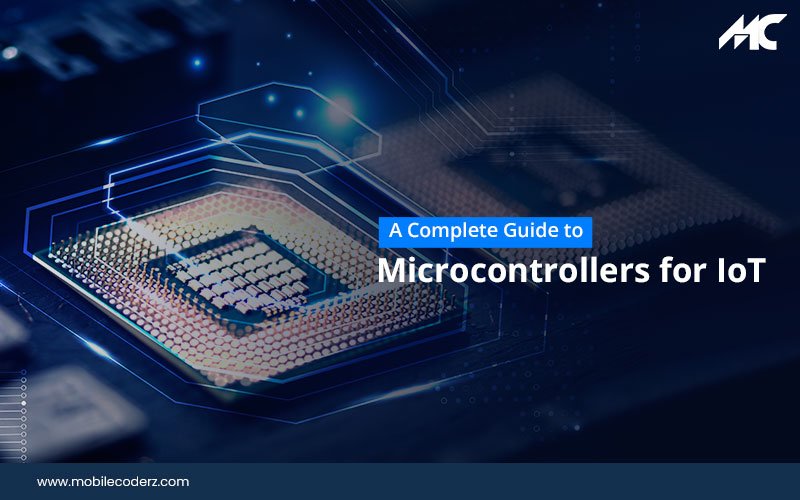A Complete Guide to Microcontrollers for IoT

The majority of IoT applications need more than simply adding sensors to an existing object. When people speak of smart objects, they’re mostly talking about the use of a microcontroller connected to the Internet. Microcontrollers are thought of as small computers that can be attached to any physical item or space. They are composed of one or more processors for computers together with the memory of the device and also programmable input/output peripherals within a single integrated circuit. Thus, there are direct links between the MCU & IoT app development.
MCUs are distinct from microprocessors used in PCs. They are designed specifically for embedded applications in which computing isn’t the sole goal of the application.
Although MCUs offer fewer capabilities than standard processors, their cost is low. It makes them an ideal choice to add computing capabilities to any object, space, or process that doesn’t contain them.
Think of bridges, warehouses, or industrial machines which don’t typically contain computers. In such instances, the addition of an internet-connected microcontroller can provide enough computing capability to boost these items without the cost and complexity of conventional computer processors. We will go through every possible aspect of microprocessor &IoT app development.
What is a Microprocessor: An Overview
Microcontroller units (MCU) are tiny self-contained computers that are placed within one integrated circuit or microchip. They are different from your typical desktop computer. They’re usually focused on a specific function and are usually included in other devices.
Characteristics of Microcontrollers
To be able to determine the microcontroller that will work most effectively for your IoT app development project, it is necessary to understand the most important capabilities of microcontrollers and the things they can do. Here are some specs you’ll come across and must be aware of when you’re looking through an MCU. All these features are important in IoT application development.
RAM
RAM is a rapidly-accessible memory that doesn’t store information in the absence of power. Each MCU has certain amounts of RAM that allows the microcontroller to swiftly perform various tasks. The more RAM you have, the better, but increased RAM will increase the price of the MCU.
Bits
Microcontrollers are usually sold according to the number of bits they can provide. This can affect the speed with which they can do non-trivial calculations.
Flash
Flash is a type of computer memory that keeps data even when there is no power. It is necessary, and it’s great for features such as offline storage.
Connectivity
This is the way that the board connects to the Internet through WiFi, Ethernet, or some other method. This is a crucial aspect of connected sensor applications.
GPIO
GPIO refers to general-purpose input/output pins. They are pins that are used to connect your actuators and sensors to the MCU and to the internet. There are a variety of pins that vary from one to hundreds according to the microcontroller.
Development Tools
It is essential that there exists a well-established toolkit that includes documentation, as well as community support for building programs that can work on any MCU you choose to run your program.
Power Consumption
The power consumption of a device is crucial in connected sensor applications particularly when the device relies on things like batteries or solar energy sources. This specification will reveal how energy-hungry the MCU is on a regular basis. And if it is able to use power-conscious programming methods.
Microprocessor: The Right Choice for IoT App Development !!
Simplicity
In the majority of IoT app development scenarios, the ease of using an MCU is an advantage, not being a drawback. MCUs do not require operating systems in order to perform their functions. They are easy to connect with other devices like sensors and motors. Their absence of external dependencies makes them simple to set up. It is easy to switch them on, then upload firmware and they will function. Furthermore, the code needed to program an MCU is very minimal.
Security
Because of their simplicity, MCUs offer the least number of avenues to attack. In general, every open port and protocol could be a security risk. The code running on MCUs is bare metal. This means it does not have an intermediary operating system that can execute instructions. This creates fewer attack vectors, & more security. All in all, it is secure when combined with IoT app development.
Cost
In today’s most modern IoT applications, MCUs are able to provide all the power and capabilities that one requires. Therefore MCUs are typically the most cost-effective, economical hardware option to use in IoT applications. In general, they provide easy and secure functionality at a low cost. Therefore, it limits the cost of IoT application development.
Choosing the Best MCU
Tech Specifications
The technical specifications that the MCU must-have will be contingent completely on its intended purpose. The importance of specifications such as processing speed or memory capacity will vary depending on the use case. For instance, an IoT app development device designed to perform more intensive tasks will require an MCU with a faster clock speed. Tasks that are less demanding, however, may not require high-performance hardware.
This is why it’s crucial to clearly define your requirements in terms of technology prior to selecting a particular device for IoT app development. The most important considerations for specs are memory, speed, power usage, security features, and the type of connectivity.
You may also like: https://entertolearn.net/the-best-apps-to-download-videos-from-the-internet/
Cost
All of these technical specifications will be evaluated against their price. The price of MCUs is decreasing rapidly. However, the addition of memory, power, and other specifications typically results in an increase in expenses. The expense of hardware might not appear intimidating at first. But an increase in the scale of hardware can quickly increase small differences in hardware prices.
However, choosing an MCU that has just the minimum specifications necessary to function could make it impossible to implement upgrades, new features or other enhancements in the near future.
Support
When choosing an MCU, it’s also crucial to consider the surrounding community. MCUs that aren’t widely used will have fewer resources to help you develop. Devices such as the Photon, however, on the contrary, have vast communities of developers. Users and the wider community make it simpler to get help and resources when needed.
With over 100,000 engineers and developers, the Particle platform comes with a variety of resources. It includes examples of projects, demos, and tools for development. Additionally, by choosing an MCU with a greater number of users and a more widely used processor, you can make sure that the integration of your IoT device with cloud services will be a breeze.
For the best microprocessors in relation to IoT application development, it is advisable to hire IoT app developers and let the experts handle complex projects.
Final Say
The IoT app development product is an integrated system, not simply a component. When designing any aspect of your project, it is important to consider the entire array of software, hardware, and infrastructure. With more than 100 microcontrollers on our market today, this guide will allow you to evaluate their capabilities and help you make the best choice.
Authors Bio
Harry Miller is an expert app developer at MobileCoderz, an established Web & Mobile app development company. With more than 9 years of professional expertise, he/she has worked with leading startups and big businesses. Apart from the app industry experience, he/she loves traveling & reading novels.






3 Comments